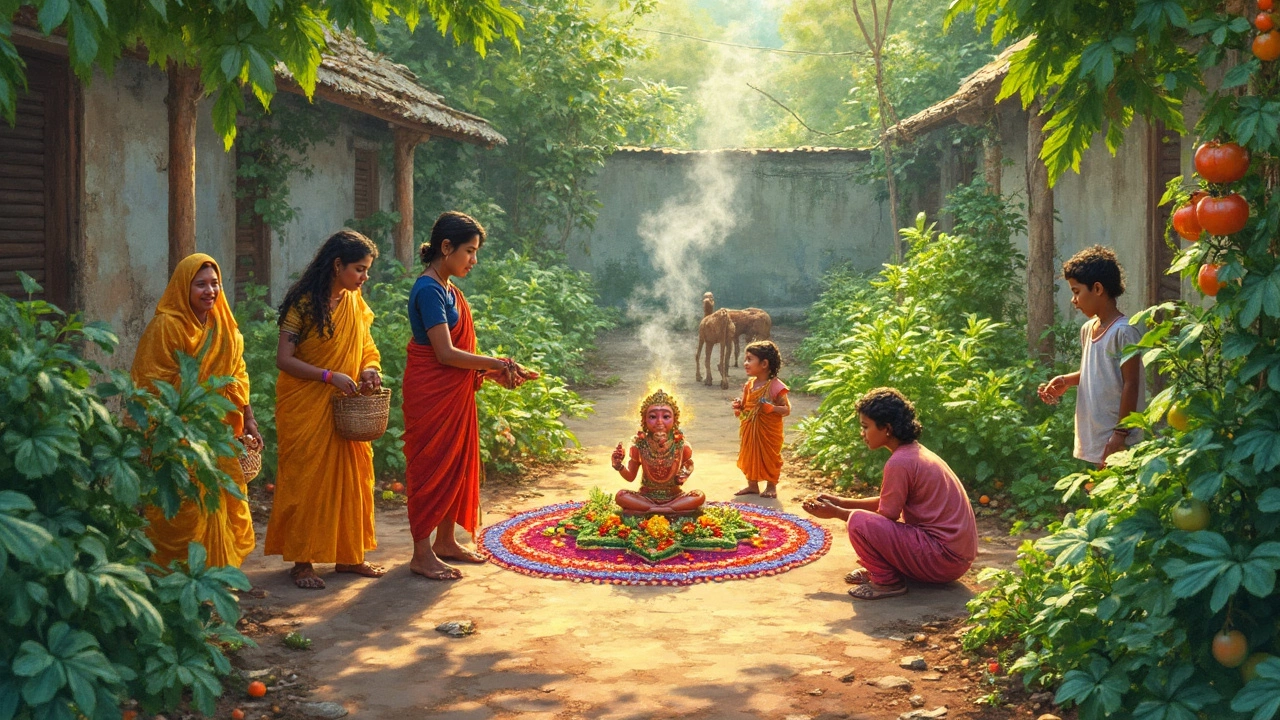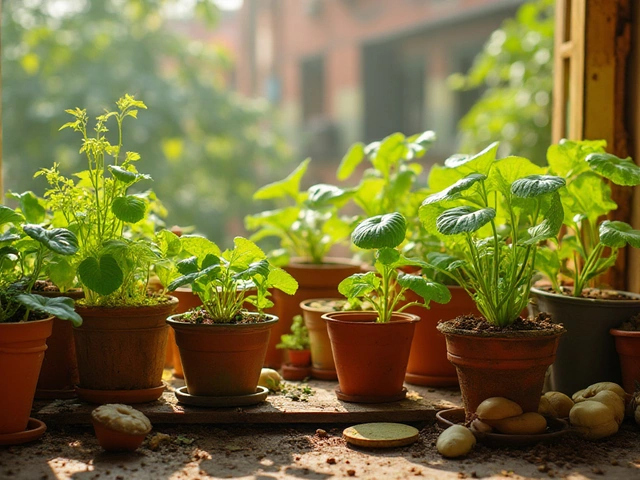Searching for the Indian god of vegetables? You won’t find a single name popping up in ancient texts or on temple altars. Unlike rice or wheat, veggies don’t have their own superstar god in Indian mythology. But that doesn’t mean vegetable gardeners are left out. In fact, people across India regularly thank higher powers for healthy gardens—just not a god with a clear veggie label.
Most Indian households look to gods like Annapurna, the goddess of food, or even Lord Krishna, pictured with lush fields in the background, for a good harvest. In some places, folks offer the first tomato or brinjal from their garden to their home shrine. Little rituals like this help gardeners feel connected both to tradition and their plants.
Even if you’re not big on rituals, it’s handy to know why so much prayer and gratitude gets mixed into gardening here. Understanding these customs gives you a sneak peek into what makes a garden really thrive—not just soil and seeds, but that extra bit of care and community.
- Is There an Indian God of Vegetables?
- The Role of Mythology in Gardening Traditions
- Popular Gods Linked to Agriculture and Harvest
- Unique Regional Rituals for Vegetable Gardens
- How Beliefs Can Help Your Garden Grow
- Down-to-Earth Tips for a Bountiful Veggie Patch
Is There an Indian God of Vegetables?
So, the big question—does India have a real-life Indian god of vegetables? Straight answer: nope, not in the way you'd expect. If you dig into old texts or ask folks in local temples, you won’t find a single god who is all about vegetables. Grain crops like rice and wheat get the spotlight in most myths, not your everyday veggies like bottle gourd or spinach.
Instead, vegetables kind of hitch a ride with bigger gods and goddesses who cover a wide range of food or farming. For example, Annapurna is worshipped as the goddess of food and nourishment. She isn’t just offering up dal-chawal; the idea is any kind of harvest, including veggies, falls under her blessings. Krishna is often linked to farming and abundance, thanks to those stories where he grew up surrounded by fields and cows.
Some villages in India have their own local spirits or deities that folks thank for a good vegetable patch. But there's no nationwide superstar. Instead of one “vegetable god,” you’ll see people offering the first brinjal, cucumber, or okra to their household gods, which could be anyone from Ganesha to a favorite ancestor.
Here’s a quick glance at who’s usually called upon for any kind of crop—not just veggies:
- Annapurna: Main goddess for food and nutrition across many homes.
- Krishna: Symbol of agricultural life and prosperity.
- Local Gram Devtas: Village gods or spirits, thanked at the start of planting season.
So when you hear someone mention the Indian god of vegetables, it’s more about keeping traditions alive and showing gratitude than following a strict myth or temple ritual. No veggie-only god exists, but the blessings and beliefs still matter if you want to keep your garden thriving.
The Role of Mythology in Gardening Traditions
Ask anyone who’s grown up in India about their earliest garden memories, and most will toss in a story about gods and vegetables. These tales might not mention a dedicated Indian god of vegetables, but mythology still shapes how people handle seeds, soil, and harvests.
Here’s what stands out: Indian culture mixes religion and nature everywhere, especially in vegetable gardening. For example, some families pray to Lord Ganesha before planting, hoping his good luck rubs off on the first shoots. In rural Maharashtra and parts of Tamil Nadu, folks often sprinkle Ganga water across garden beds, trusting in the river’s sacred history for better yields.
Certain festivals make this link even clearer. During Sankranti, Pongal, or Ugadi, gardeners bring their first vegetables as offerings. This isn’t just about faith—it’s about showing thanks for nature’s bounty. The belief is simple: if you respect the earth and honor the cycle of planting and harvest, your veggies will thank you back.
- Planting with intention: Stories from the Mahabharata and Ramayana teach that everything in the garden has a role. Seeds aren’t just seeds—they’re part of a big, sacred loop.
- Symbols matter: Many Indian homes keep a Tulsi (holy basil) plant because it’s connected to the goddess Tulsi. While it’s not a vegetable, the habit shows how plants and legends go hand in hand.
- Protective rituals: In Bengal, some growers stick a scarecrow with a red cloth as an ‘evil eye’ ward—another mix of gardening and belief.
These traditions aren’t just for show. Because of them, more people in India eat fresh veggies and value homegrown food. According to a 2023 survey by the Indian Council of Agricultural Research, about 48% of urban home gardens in India have at least one ritual tied to planting or harvest.
So, while the vegetable gardening India scene lacks a single patron god, old myths and customs still steer how people grow and treat their crops.
Popular Gods Linked to Agriculture and Harvest
When you talk to gardeners or farmers in India, it’s clear that vegetables might not have a god of their own, but plenty of important gods have a hand in fields and harvests. These deities are called on for everything—good weather, healthy crops, and protection from pests. If you’re trying to get the hang of vegetable gardening in India, it helps to know who gets the credit when the tomatoes finally show up.
Here’s a quick breakdown of the main gods people connect with anything green and growing:
- Annapurna: Known as the goddess of food and nourishment, she’s often thanked when gardens produce well. Her blessings mean every meal gets a little extra love—which is why many offer homegrown veggies at her shrine.
- Krishna: Everyone’s seen paintings of Krishna playing in fields or surrounded by cows and plants. In many villages, he’s considered a protector of crops, especially since he grew up in a farming family. In some rural areas, folks believe praying to Krishna keeps their veggies safe from storms.
- Shiva: Especially in South India, Shiva is worshipped for rainfall and fertile lands. Some temple festivals even include special prayers for bumper harvests or the start of the planting season.
- Bhumi Devi (Mother Earth): She’s the classic go-to when you want the soil to treat you right. Many people thank Bhumi Devi before sowing seeds or when pulling the first basket of homegrown veggies.
- Surya (the Sun God): Nothing grows without sunlight. Surya is offered prayers for enough sunshine—especially during the critical growing months.
Check out this quick table to see where these gods are most often prayed to and what for:
| God/Goddess | Main Role | Popular Regions |
|---|---|---|
| Annapurna | Food, harvest blessing | All over India, especially temples in Varanasi |
| Krishna | Crop protection, community farming | Northern and Western India |
| Shiva | Rain, fertility | Tamil Nadu, Karnataka, Andhra Pradesh |
| Bhumi Devi | Soil health | Pan-India, often rural regions |
| Surya | Sunlight, plant energy | Jharkhand, Chhattisgarh, Uttar Pradesh |
While none of these gods has a stamp on "god of vegetables," their blessings are part of the daily lives of vegetable gardening India enthusiasts. When you step into your kitchen garden or field, it’s almost like joining a huge, living tradition—maybe with a small prayer before you pull those carrots out of the ground.

Unique Regional Rituals for Vegetable Gardens
Across India, you’ll see home gardeners doing some pretty interesting things in their vegetable gardening India patches. These aren’t just for show—they’re small acts that locals believe help veggies grow better or stay safe from bad luck.
In Tamil Nadu, some folks tie a red cloth or small dolls called "Bommai" to the fence or a pole in their vegetable gardens. They do this to ward off the "drishti" (evil eye). The first harvest often gets offered at the family altar, especially during festivals like Pongal, when freshly harvested veggies become part of the puja.
In parts of Maharashtra, before planting the first seeds, people sprinkle a handful of turmeric and kumkum (red powder) on the soil. It’s their way of thanking the Earth and hoping for a good crop of tomatoes, brinjals, or chillies. You’ll also hear about pouring the first bucket of water in the name of their family deity or Annapurna. Little things like that add a personal touch, and honestly, it’s a reminder to slow down and pay attention to what’s growing.
Bengali households might put up banana leaves, or clay pots painted in bright colors near their backyard vegetable patches to invite luck during the festival of Nabanna. States like Odisha and Andhra Pradesh often start the cropping season with a "Bhoomi Puja"—a simple prayer and coconut-breaking at one corner of the home garden to ‘wake up’ the soil spirit.
If you head to Gujarat around Uttarayan, you’ll notice people celebrating their first harvest of winter vegetables with sweets and small gifts exchanged with neighbors. Sharing a few brinjals or pigeon peas can be just as important as any ritual, bringing the local community closer together.
- Always check with older neighbors—they often know rare, hyper-local rituals you won’t read about online.
- If your garden feels sluggish, try your hand at a region’s time-tested custom (even if only for the fun of it!).
- Many of these rituals use common items: red thread, coconut, flowers. You usually have them at home already.
Indian god of vegetables is not a fixed idea, but these creative rituals show how different regions give thanks and hope for the best harvest. Bring a bit of these traditions to your own patch, and you’ll feel more connected to the wider gardening world around you.
How Beliefs Can Help Your Garden Grow
Whether you call it tradition, habit, or just family belief, all that ritual and respect around gardening actually pays off. In India, tying religious customs and vegetable gardening together adds more than just charm—it builds patience and dedication, two things every gardener needs.
When you see people offering the first harvest to a deity, it’s more than a gesture. Studies have shown that folks who attach emotional meaning or gratitude to gardening tasks are more consistent with watering, weeding, and looking after plants. In short, belief keeps you invested. If you’re invested, your plants get better care. It’s almost like a low-key gardening hack hidden in plain sight.
There’s another upside—sharing rituals or prayer time with family or neighbors creates mini-communities around the vegetable gardening India scene. You get advice from elders, seeds from a neighbor, or kids who want to help water after hearing the old stories. That vibe of togetherness can mean fewer forgotten watering days and less chance your tomatoes will wilt.
- Gardening rituals set up regular routines, like checking plants for pests on special days.
- Making a small offering or prayer can boost your own motivation to keep up with chores.
- Taking pride in cultural traditions keeps you looking forward to each growing season.
- Community gardening events tied to festivals can help you swap tips, seeds, and support.
Don’t feel left out if you’re not into rituals. You can create your own habits—maybe setting a reminder to check the soil every Sunday morning, or promising yourself you’ll share your first harvest with someone else. Belief doesn’t have to be religious; consistency and gratitude go a long way, no matter the faith.
| Habit Inspired by Belief | Impact on Gardening |
|---|---|
| Weekly prayers or rituals | Better plant check-ups and early pest spotting |
| Harvest offerings to gods or elders | More attention to plant health and yield |
| Community festivals and seed swaps | Access to diverse seeds and local advice |
Mixing a bit of tradition into your daily routines can make vegetable gardening not just productive, but a whole lot more rewarding and fun. However you do it, habits wrapped up in beliefs often mean happier plants—and happier gardeners, too.
Down-to-Earth Tips for a Bountiful Veggie Patch
If you want your vegetable gardening India project to actually feed your family, focus on a few down-to-earth tricks that work anywhere from a city balcony to a rural backyard. It’s not about magic—just getting the basics right.
- Soil quality matters most. Most vegetables need loose, well-draining soil loaded with compost. Clay soil? Mix in cocopeat, sand, or even leaf compost to keep it looser. Sandy soil? Add organic matter so water doesn’t run right through.
- Rotate your crops. Don’t plant the same veggie at the same spot every year. Tomatoes in one bed this year? Switch to beans or okra next time. Crop rotation cuts down pest buildup and avoids draining all nutrients from one spot.
- Seed choices are key. Pick seeds from reliable brands or, better, swap with local gardeners. Heirloom seeds might give you tastier veggies and save money each season.
- Watch your watering. Most Indian veggies want about an inch of water a week. Deep, infrequent watering beats a daily sprinkle—roots go down deeper, and plants toughen up. Early morning or evening is best, so less water evaporates.
- Pest control without chemicals. Neem spray and homemade garlic-chili paste work for most small bugs. Net your beds with old mosquito mesh to stop bigger pests. Ladybugs and frogs in your garden? Leave them be—they eat loads of common pests.
Here’s a quick table showing the best months for sowing some common veggies if you want year-round harvests:
| Vegetable | Best Sowing Months (India) |
|---|---|
| Tomato | Dec-Feb, June-July |
| Bhindi (Okra) | Feb-March, June-July |
| Beans | July-Sept |
| Coriander | Oct-Dec, Feb-March |
| Brinjal (Eggplant) | Jan-Feb, June-July |
Don’t forget to mix flowering plants like marigold or basil with your veggies—they help attract bees and pest-eating insects, which means healthier plants and bigger harvests. Even if you skip any rituals, following these small steps makes your garden look like you’ve got the original Indian god of vegetables on your side.





